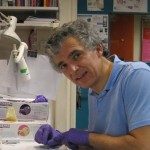Link to Pubmed [PMID] – 14504281
J. Biol. Chem. 2003 Dec;278(49):49537-48
The glycine-tyrosine-glycine (GYG) sequence in the p-loop of K+ channel subunits lines a narrow pore through which K+ ions pass in single file intercalated by water molecules. Mutation of the motif can give rise to non-selective channels, but it is clear that other structural features are also required for selectivity because, for instance, a recently identified class of cyclic nucleotide-gated pacemaker channels has the GYG motif but are poorly K+ selective. We show that mutation of charged glutamate and arginine residues behind the selectivity filter in the Kir3.1/Kir3.4 K+ channel reduces or abolishes K+ selectivity, comparable with previously reported effects in the Kir2.1 K+ channel. It has been suggested that a salt bridge exists between the glutamate-arginine residue pair. Molecular modeling indicates that the salt bridge does exist, and that it acts as a “bowstring” to maintain the rigid bow-like structure of the selectivity filter and restrict selectivity to K+. The modeling shows that relaxation of the bowstring by mutation of the residue pair leads to enhanced flexibility of the p-loop, allowing permeation of other cations, including polyamines. In experiments, mutation of the residue pair can also abolish polyamine-induced inward rectification. The latter effect occurs because polyamines now permeate rather than block the channel, to the remarkable extent that large polyamine currents can be measured.
